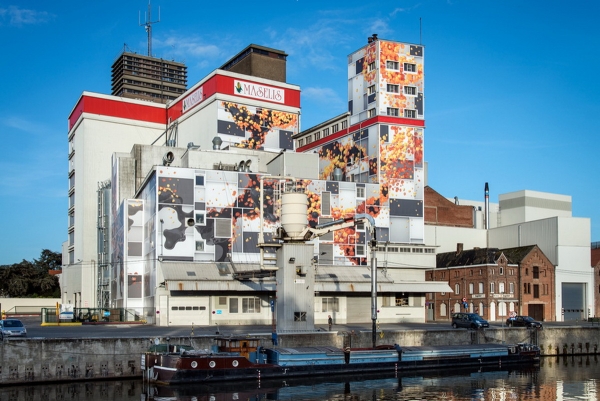NIARGTZAG
Toegevoegd op 19 januari 2015 door sne

Afbeelding toegevoegd door sne
Commissioned by Kanal (an outdoor exhibition praising local industry in Roeselare) the NAIRGTZAG (2012) print is almost 2000m² large and wraps up the complete Maselis grain factory. The inspiration for NAIRGTZAG was found in the physical features of the building, as well as in the activities of the factory and the history of the site and its surroundings. By referring to the local history, Ervinck aimed at producing a new history and thus adding layers to the urban landscape.
Unlike the works of the artist Christo, Ervinck makes visible the functions, materials and production process on the outside walls. Moreover, making this monumental computer drawing, Ervinck played with the various obstacles of the building, such as grates, drainage pipes, ... throwing the viewer in confusion whether the visible elements are real or virtual. NAIRGTZAG is a cross-section of the factory as a labyrinth. The squares and grids that determine the building, are now part of the sculpture. Ervinck thus designed an artwork, bringing into question the borders between outside and inside, and between the virtual and the real.
Commissioned by Kanal (an outdoor exhibition praising local industry in Roeselare) the NAIRGTZAG (2012) print is almost 2000m² large and wraps up the complete Maselis grain factory. The inspiration for NAIRGTZAG was found in the physical features of the building, as well as in the activities of the factory and the history of the site and its surroundings. By referring to the local history, Ervinck aimed at producing a new history and thus adding layers to the urban landscape. Unlike the works of the artist Christo, Ervinck makes visible the functions, materials and production process on the outside walls. Moreover, making this monumental computer drawing, Ervinck played with the various obstacles of the building, such as grates, drainage pipes, ... throwing the viewer in confusion whether the visible elements are real or virtual. NAIRGTZAG is a cross-section of the factory as a labyrinth. The squares and grids that determine the building, are now part of the sculpture. Ervinck thus designed an artwork, bringing into question the borders between outside and inside, and between the virtual and the real.
